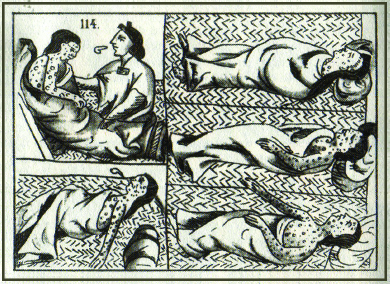| << Chapter < Page | Chapter >> Page > |
Native peoples also introduced Europeans to chocolate, made from cacao seeds and used by the Aztec in Mesoamerica as currency. Mesoamerican Indians consumed unsweetened chocolate in a drink with chili peppers, vanilla, and a spice called achiote. This chocolate drink— xocolatl —was part of ritual ceremonies like marriage and an everyday item for those who could afford it. Chocolate contains theobromine, a stimulant, which may be why native people believed it brought them closer to the sacred world.
Spaniards in the New World considered drinking chocolate a vile practice; one called chocolate “the Devil’s vomit.” In time, however, they introduced the beverage to Spain. At first, chocolate was available only in the Spanish court, where the elite mixed it with sugar and other spices. Later, as its availability spread, chocolate gained a reputation as a love potion.
Visit Nature Transformed for a collection of scholarly essays on the environment in American history.
The crossing of the Atlantic by plants like cacao and tobacco illustrates the ways in which the discovery of the New World changed the habits and behaviors of Europeans. Europeans changed the New World in turn, not least by bringing Old World animals to the Americas. On his second voyage, Christopher Columbus brought pigs, horses, cows, and chickens to the islands of the Caribbean. Later explorers followed suit, introducing new animals or reintroducing ones that had died out (like horses). With less vulnerability to disease, these animals often fared better than humans in their new home, thriving both in the wild and in domestication.
Europeans encountered New World animals as well. Because European Christians understood the world as a place of warfare between God and Satan, many believed the Americas, which lacked Christianity, were home to the Devil and his minions. The exotic, sometimes bizarre, appearances and habits of animals in the Americas that were previously unknown to Europeans, such as manatees, sloths, and poisonous snakes, confirmed this association. Over time, however, they began to rely more on observation of the natural world than solely on scripture. This shift—from seeing the Bible as the source of all received wisdom to trusting observation or empiricism—is one of the major outcomes of the era of early globalization.
Travelers between the Americas, Africa, and Europe also included microbes: silent, invisible life forms that had profound and devastating consequences. Native peoples had no immunity to diseases from across the Atlantic, to which they had never been exposed. European explorers unwittingly brought with them chickenpox, measles, mumps, and smallpox , which ravaged native peoples despite their attempts to treat the diseases, decimating some populations and wholly destroying others ( [link] ).

In eastern North America, some native peoples interpreted death from disease as a hostile act. Some groups, including the Iroquois, engaged in raids or “ mourning wars ,” taking enemy prisoners in order to assuage their grief and replace the departed. In a special ritual, the prisoners were “requickened”—assigned the identity of a dead person—and adopted by the bereaved family to take the place of their dead. As the toll from disease rose, mourning wars intensified and expanded.
In the minds of European rulers, colonies existed to create wealth for imperial powers. Guided by mercantilist ideas, European rulers and investors hoped to enrich their own nations and themselves, in order to gain the greatest share of what was believed to be a limited amount of wealth. In their own individual quest for riches and preeminence, European colonizers who traveled to the Americas blazed new and disturbing paths, such as the encomienda system of forced labor and the use of tens of thousands of Africans as slaves.
All native inhabitants of the Americas who came into contact with Europeans found their worlds turned upside down as the new arrivals introduced their religions and ideas about property and goods. Europeans gained new foods, plants, and animals in the Columbian Exchange, turning whatever they could into a commodity to be bought and sold, and Indians were introduced to diseases that nearly destroyed them. At every turn, however, Indians placed limits on European colonization and resisted the newcomers’ ways.

Notification Switch
Would you like to follow the 'U.s. history' conversation and receive update notifications?